How to penetrate ships
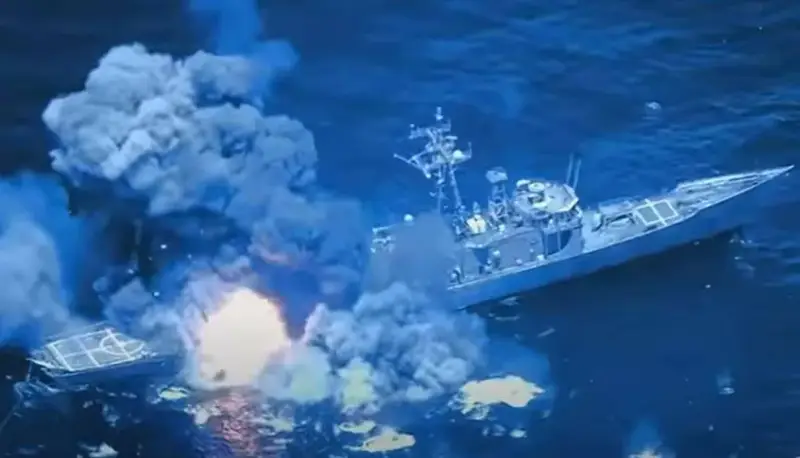
There is a sound barrier behind - and a target looms ahead. “It will pierce the ship to the very bottom”!
But what is hidden behind the exclamation? Do the size and high velocity of the ammunition matter when it hits a ship?
Here are three examples from different eras. World War II, the 50s of the last century and modern solutions.
Guided bombs for the Luftwaffe
... "Fritz" pierced seven decks like sheets of foil. A moment later, the bottom was knocked out - and the bomb buried itself in the water column. There its fuse woke up - 320 kilograms of ammotol shook the cruiser, the boiler furnaces went out and the cars stopped.
At this point, season 43 was completed. Tons of water poured into the damaged compartments. The crew of the Uganda lost 16 people - out of nine hundred sailors on board.
The KG/100 bomber squadron scored a “cross” for successfully hitting the target. But the results of using a one and a half ton guided bomb turned out to be, to put it mildly, inexpressive. So, a couple of years before the events described, Messerschmitt fighters managed to deal with the light cruiser Fiji (of the same type as Uganda) using 250 kg of air bombs.
Of course, the caliber has no direct connection with the amount of damage. Many factors matter. But story with the "Uganda" appears in an obvious light - the cruiser and its crew very successfully survived the meeting with the "wunderwaffe". Few ships had the chance to experience bombs of this caliber.
"Uganda" received a major hole. The cruiser's mechanisms were damaged, but it stayed afloat with a working propeller. After ersatz repairs in Malta, the cruiser headed under its own power across the ocean. Subsequently, already under the Canadian flag, he operated in the Pacific theater of operations.
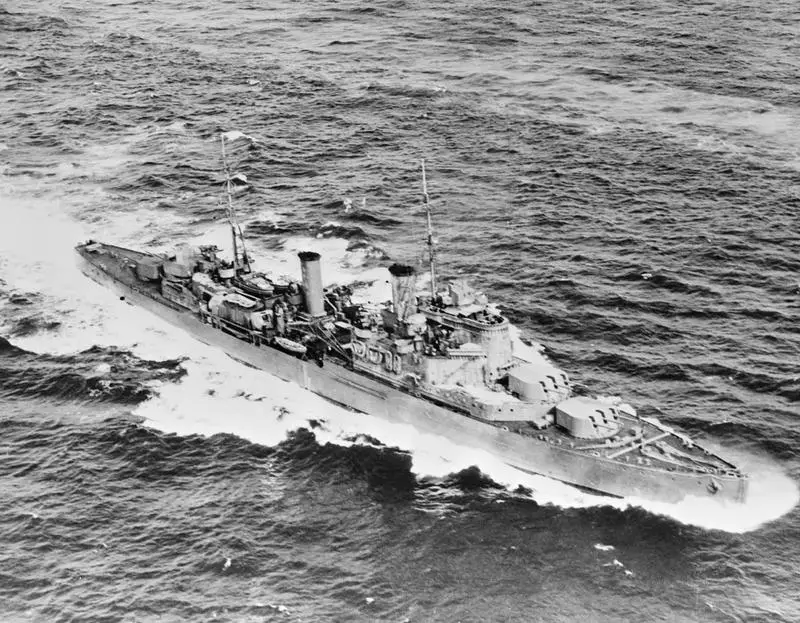
The size and combat value of the "Uganda" did not require the use of particularly large caliber gliding bombs against it. That day the German bomber was simply looking for any target.
The whole story was about how weak the impact of the guided bomb, which had a mass of 1,5 tons, turned out to be.
Penetrating the enemy is the worst-case scenario.
The durability of the ammunition and the supply of kinetic energy are necessary only to overcome the defense. If the protection was broken (or was absent initially), then the unspent reserve of kinetic energy became a problem for the ammunition itself.
A through hole means that a hole has formed in a structure weighing thousands of tons, the transverse dimensions of which are negligible compared to the size of the target. If there are 10–15–20 waterproof compartments, a hole in the bottom is not a mortal threat.
You can hit the sheathing with a crowbar more effectively.
If the ammunition penetrates the inside of the ship, then its speed, rotation, and mass cease to matter. Flying through compartments, trying to crush something, chop it up, cut ammunition with your own body - all this is not very useful fuss.
The sea target, due to its colossal size, must be blown up. Therefore, the success of the attack depends on the reliability of the detonator and the amount of explosive contained in the warhead.
In rare cases, it was possible to do without explosives - it was enough to set the ship on fire. As you know, the destroyer Sheffield was burned by a missile stuck in its hull with a “running engine.”
Wait, how is this even possible?
What will remain of the fragile compressor blades and turbines of a turbojet engine after hitting metal bulkheads at a speed of 900 km/h?
The only French anti-ship missile "Exocet" had a sustainer solid propellant rocket engine. In other words, a multi-kilogram firework was stuck in the Sheffield’s hull, spewing jets of fire for several minutes.
But still, explosives are more effective.
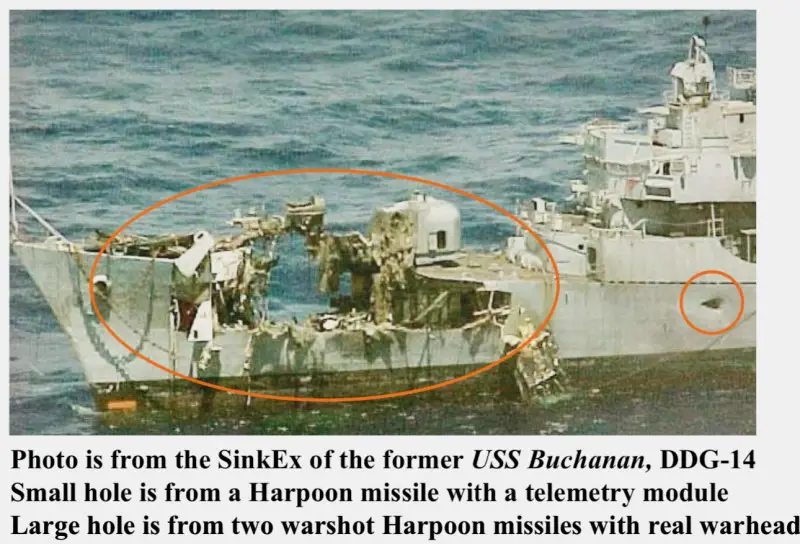
The destroyer Buchanan turned into a target (1960). To be fair, its dimensions were only slightly larger than those of a modern corvette. Small hole - corresponds to a hit by the Harpoon anti-ship missile with an inert warhead. The heavily damaged nasal extremity is the result of exposure to two similar anti-ship missiles in combat equipment.
And we are transported again to the 1940s.
The extreme penetration ability played a cruel joke on “Fritz”
When creating the Fritz-X, the armor-piercing bomb PC.1400 was chosen as the basis, whose index clearly hinted at the value of its mass.
A very desperate choice - for a bomb that was planned to be thrown from a height of 5-6 kilometers. Having accelerated to the speed of sound, the 1-kilogram “Fritz” acquired incredible penetrating power!
The deck was struck by ammunition that was heavier than the 460-mm Yamato projectile. Only the shells were designed, among other things, to penetrate the vertical protection of the side, which was many times thicker than any horizontal armored deck. And the trajectories of the projectiles did not suggest such favorable angles of meeting the target - like those of a vertically falling Fritz-X.
The chronicle of combat use leaves no doubt - bombs too often, having flown through the entire hull, exploded somewhere in the water.
Uganda, Savannah, Roma, Littorio and Warspite. All of them had eight Fritz-X hits. And in six cases these were through wounds.
In materials devoted to the German superbomb, the ability to penetrate seven decks is presented as an obvious advantage and proof of the power of the Fritz.
But it seems that this was far from the case. The explosion outside the hull blurred the full effect of the successful attack.
Bombs weighing 1,5 tons were not created just to scratch giants. The effect of their hits was disproportionately greater when the explosions occurred inside the hull.
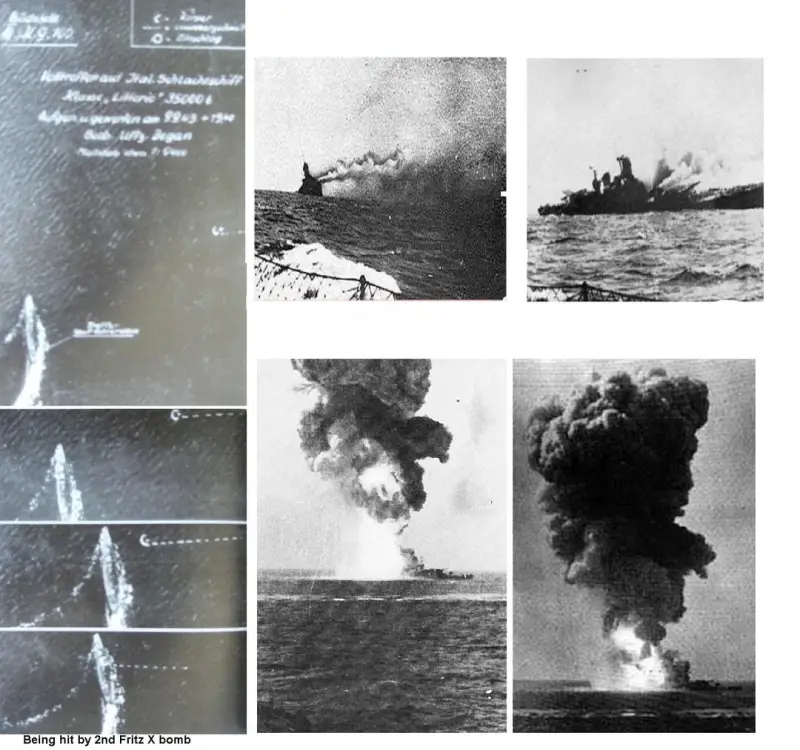
Thus, the only victim was the Italian Roma. And again - the first "Fritz" left a hole in the bottom, without any definite result.
A new attack followed. And - suddenly! The fuse went off a moment earlier. "Fritz" exploded inside the hull.
The death of Roma showed what happens when the bomb doesn't hit the hole.
...Before the end of the war, the Germans managed to produce hundreds of “Fritz”. The number of large ships among the Allies increased. But the gliding armor-piercing Fritz-X was never used in combat again. It remains to speculate about the reasons for such a disdainful attitude towards the “wunderwaffe” on the part of the Germans themselves.
Can-opener
We are transported to the next era.
At a time when giants still ruled the sea - ships built to 1940s standards. But now they had a meeting with the Soviet anti-ship weapons.
The world's first samples of anti-ship missiles. Massive and bulky, with an engine from a Yak-25 fighter jet.
Contrary to modern ideas, Soviet designers did not believe in the ability of anti-ship missiles to disable an American cruiser (Baltimore or Des Moines) when a missile hit the surface.
Even such a huge missile as the KSShch (ship-based projectile “Pike”).
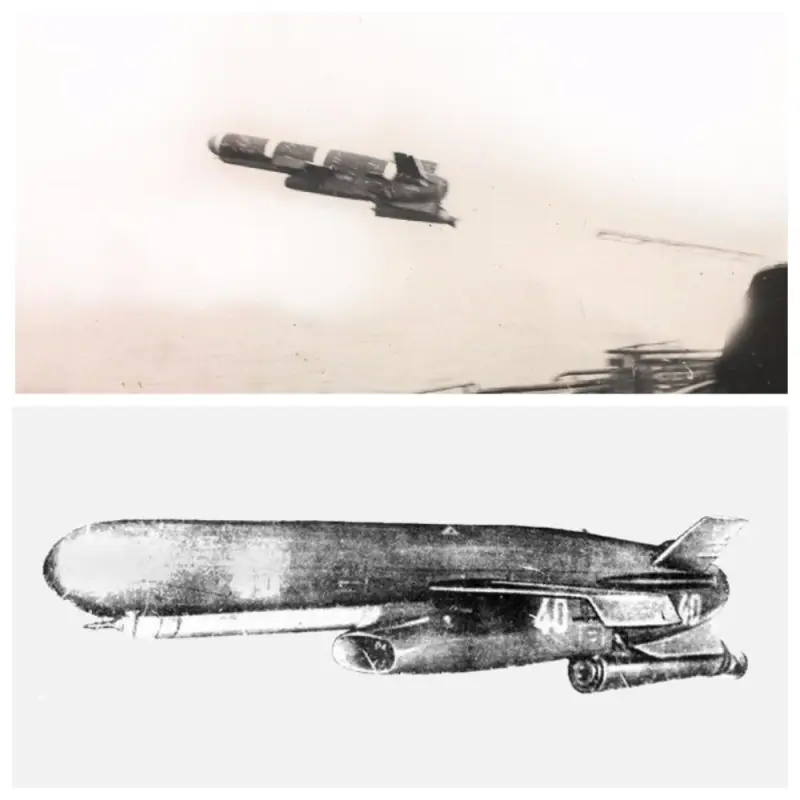
Indeed, it was strange to expect the destruction of a 200-meter ship when a Yak-15 jet fighter (whose take-off weight approximately corresponded to the starting weight of the KSShch) fell onto its deck.
With this description, the depth of the problem becomes noticeable.
3 tons versus 18 tons.
No, the example of the German “Fritz” has nothing to do with it. Although the speed of the “Pike” and “Fritz” was approximately the same.
The Fritz-X bomb itself was a “warhead” that was delivered to the target using a special carrier (aircraft). A one and a half ton blank, 80% made of high-strength steel.
“Pike” is an aircraft, i.e. a rather fragile object, like everything that belongs to the sphere aviation and rocket technology. Where the warhead itself accounted for only 600 kg, of which about half was explosive.
The crazy “Fritz” could break through 150–200 mm of structural horizontal protection with its body and fly out of the hull.
The combat unit of the "Pike" was more modest. The walls of the warhead are thinner, the strength is less. Enough for effective penetration inside the Baltimore SRT hull. But Soviet designers saw some kind of problem. And in general they refused to hit ships on the surface.
The reason could be the analysis of battle damage during the Second World War. Pre-war cruisers could withstand several hits from kamikaze aircraft and still remain in service. Baltimore and Des Moines were even larger and more advanced. Therefore, neither the high speed of the KSShch nor the presence of a large warhead provided a guarantee of success.
A special, sophisticated attack scheme was developed for the KSSH.
The missile dived at a certain angle - with the intention of entering the water at a distance of 30-40 meters from the side of the enemy ship. The detachable warhead continued its movement under water, hitting the target below the waterline.
A hit by anti-ship missiles should have had consequences similar to a torpedo attack.
From a technical point of view, the warhead of the Pike was nothing like a torpedo. No rudders or control surfaces - everything would come off when falling into the water at transonic speed.
The warhead was a streamlined rod with an explosive charge, which moved in the desired direction by inertia, covering 30–40 meters in tenths of a second.
The difficulty was choosing the right trajectory so that the rod would not bury itself deep in the water and slip under the keel of the ship. Success depended on many random factors. The concept of a “diving warhead” was recognized as an overly bold decision, and since 1959, a modification of the “Pike” with a conventional, inseparable warhead entered service.
Now all attacks were carried out only on the surface of the ships. There are legends about how “Pikes” hit target ships during exercises.
Earlier, the author had already called useless attempts to “crush, chop, cut something with your own body of ammunition.” However, maritime history knows an example when a missile almost cut a destroyer lengthwise - in half!
I will quote one passage that is reprinted over and over again in articles devoted to the KSShch rocket. The description of the damage caused by the missile strike evokes strong feelings among the public.
At the time of launch, the rocket and the target were in the same diametral plane. The rocket hit the target in the joint of the deck and side, at the base of the rack of the stern flag. The result was a ricochet, and the rocket went along the median plane of the ship above the deck, sweeping away everything in its path. At first they were stern gun turrets, then superstructures with a rangefinder station located on them, then stern torpedo tubes. Everything was swept overboard, right up to the forecastle.
Next, the rocket entered along the forecastle, cutting it like a can opener, and got stuck in the area of the nose 130-millimeter cannon. In this case, the dockmaster fell on one side, and the bridge with the control tower and another 130-millimeter cannon - on the other. If the flight of the rocket had not been filmed on a film, no one would have believed that this could be done with the ship with one rocket, and even with an inert warhead.
The story with the “can opener” sounds impressive, if not for one thing.
In 1961, the destroyer Boykiy could not stand on its barrels and also could not drift. It was cut into metal in Sevastopol in 1959.
A colorful description of damage on an unknown ship is a glaring “flaw” in a story that claims to be historically accurate. This only confirms the author’s guess - another naval tale.
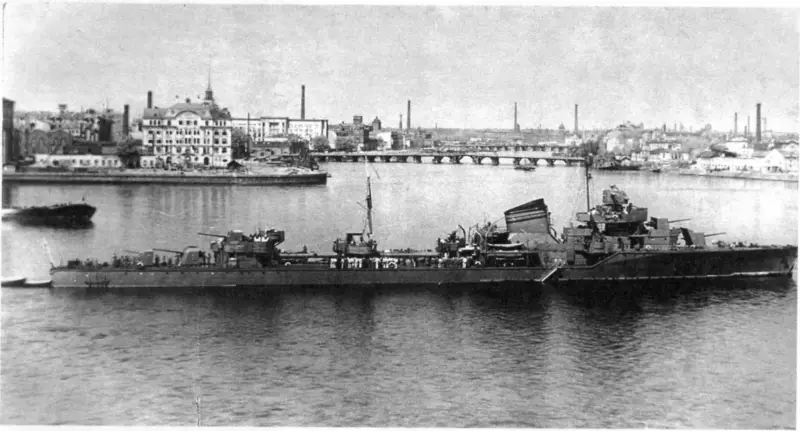
Destroyer of Project 7. Now imagine what distance the missile allegedly “overcame” - through all the structures blocking its path on the deck of the destroyer, and then through the hull to get stuck under the bow 130-mm gun mount
It’s easy and routine to rip off a torpedo tube and throw it overboard. And fly further, flapping your wings.
For a minute, the torpedo tube of the Soviet destroyer weighed more than 10 tons.
Ripping out 12-ton artillery mounts, tearing through a hundred meters of metal structures and cutting deck flooring like paper... Such tricks would require not aluminum wings, but a “weight” made of depleted uranium.
Examples from the 21st century
In the new century, an interesting episode was noted in which a rocket was able to sink a ship due to its kinetic energy.
The SM-6 Block I anti-aircraft missile, capable of targeting any radio-contrast objects, was chosen as the weapon of destruction. Including naval targets.
The target was the Reuben James, a decommissioned Oliver Perry-class frigate with a standard displacement of 4 tons.
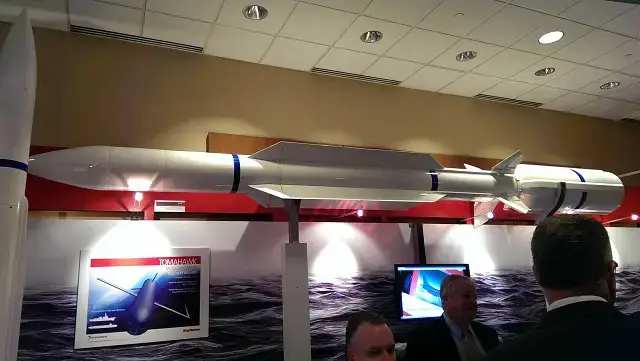
An entire ship was sunk with this thing
SM-6 or “Standard-6” is a two-stage solid-fuel missile defense system with a launch weight of about one and a half tons. After burning out 1 kg of fuel, a sustainer stage remains in flight, containing the ARGSN, control system and fragmentation warhead - almost four times less in mass than the warhead of the Harpoon anti-ship missile.
Due to their smaller warhead and questionable effectiveness against sea targets, anti-aircraft missiles were never considered as a replacement for anti-ship weapons. SAMs were launched at ships for fun. However, they were sometimes used in combat situations. Not to sink is to scare the enemy.
One can recall an incident from a naval exercise in 1992, when an American ship fired point-blank Sea Sparrow missiles at the Turkish destroyer Muavenet. The explosion of the 40 kg warhead of the first missile defense system led to the death of five crew members. The second rocket got stuck in the body and did not explode. At the same time, the “destroyer” itself, built in the 1940s, refused to sink.
The flight speed of the modern SM-6 is approximately the same as the Sea Sparrow missile system and is Mach 3,5.
The SM-6 sustainer stage has a mass of about 300 kg. The warhead is larger – 64 kg.
Moving along a ballistic trajectory, the SM-6 hit the Reuben James and pierced the frigate. He took it and sank.
Question: due to what miraculous properties did a missile with a 64 kg warhead manage to sink an entire frigate?
High speed? Kinetic energy? Come on, joke...
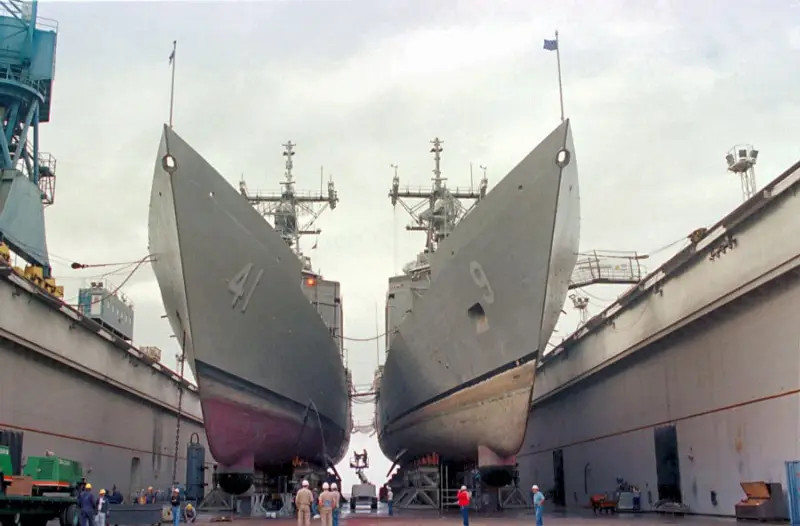
Frigates of the "Oliver Perry" type, from this angle the true dimensions of the ships, including the underwater part of the hull, become clear - in comparison with the usual things and figures of people.
SM-6 left a hole in the underwater part, the size of which is unknown. But it is clear that the hull of the Oliver Perry-class frigates was divided into 11 compartments by watertight bulkheads.
The author has a couple of comments about the reasons for the death of the frigate Reuben James, the degree of reliability of which can be assessed as undoubted.
1. There was no crew on board the target ship.
In real combat conditions, emergency parties must take control of this situation. The damaged compartment is isolated. Counter-flooding measures are being applied. There are clear standards - how many minutes after the compartment begins to flood, the ship must return to an even keel.
There was no one on board the Reuben James to do the work. The uncontrolled flow of water and the increasing tilt ultimately led to a natural result.
2. In the process of becoming a target, Reuben James was properly “undressed”. All weapons and valuable equipment were removed from it. In such cases, they do not stand on ceremony, which inevitably affected the tightness of the bulkheads. And the situation became even more complicated when water poured through the hole.
There was also a third argument, which can be assessed as “probable”.
It is known what fate awaits the target ships. The fury of all types of weapons falls upon them. For example, the destroyer Buchanan, already mentioned in this article, received a total of three Harpoons, three Hellfires, and finally was hit by a 1000-kg aerial bomb.
Therefore, it is possible that Reuben James suffered the same fate. The SM-6 missile was not the first munition to hit the doomed ship. And most likely, this was the case - the size of the missile defense system is too insignificant compared to the frigate.
Unfortunately, no one tries to pay attention to such aspects. A stupid result achieved in testing conditions is presented as a real achievement. And experts continue to admire the miracle weapon, capable of shooting down planes and sinking ships with one blow.
Summary
When evaluating anti-ship weapons, the first thing to look at is the amount of explosive contained in the warhead.
In modern conditions, speed is only necessary to overcome air defense systems. Further, everything depends on the parameters of the warhead. The kinetic energy reserve of the ammunition itself is not capable of causing noticeable damage to the ship, due to the colossal size of the naval target.
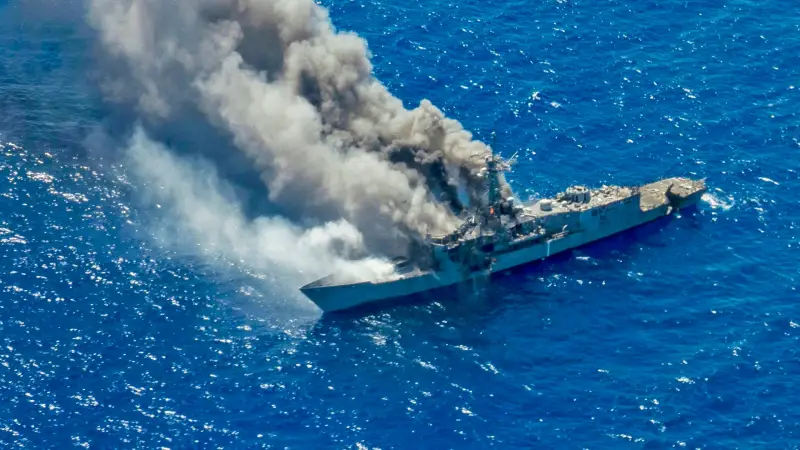
Information